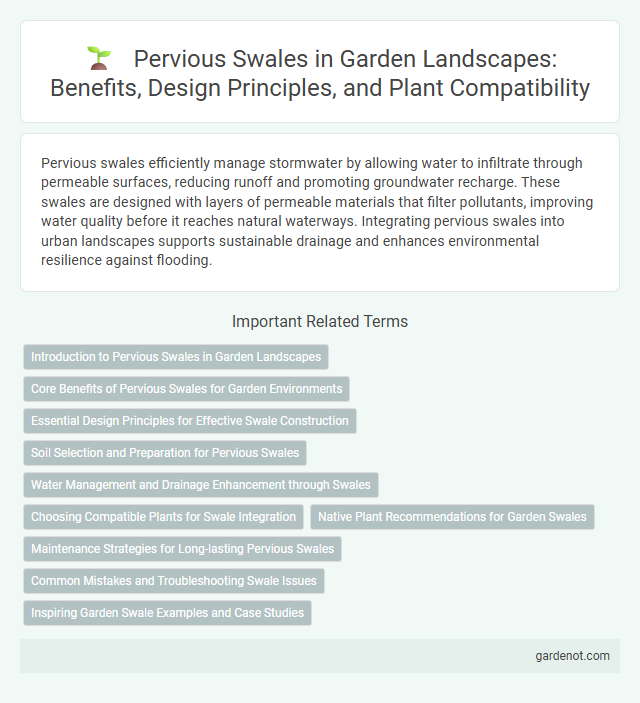Pervious swales efficiently manage stormwater by allowing water to infiltrate through permeable surfaces, reducing runoff and promoting groundwater recharge. These swales are designed with layers of permeable materials that filter pollutants, improving water quality before it reaches natural waterways. Integrating pervious swales into urban landscapes supports sustainable drainage and enhances environmental resilience against flooding.
Introduction to Pervious Swales in Garden Landscapes
Pervious swales are engineered landscape features designed to manage stormwater by allowing water to infiltrate the soil while filtering pollutants. These shallow, vegetated channels reduce runoff, improve groundwater recharge, and enhance urban garden sustainability. Incorporating native plants with deep root systems increases their effectiveness in promoting soil permeability and supporting local ecosystems.
Core Benefits of Pervious Swales for Garden Environments
Pervious swales enhance garden environments by efficiently managing stormwater runoff, reducing soil erosion, and promoting groundwater recharge through their permeable surfaces. These swales support healthier plant growth by maintaining optimal moisture levels and filtering pollutants before water reaches the soil. Integrating pervious swales in garden landscapes contributes to sustainable water management and improves overall ecosystem resilience.
Essential Design Principles for Effective Swale Construction
Effective pervious swale construction hinges on key design principles such as ensuring adequate infiltration capacity through well-graded, permeable soil media. Incorporating proper slope gradients between 1% to 5% optimizes water flow while preventing erosion and promoting infiltration. Strategic vegetation selection enhances filtration and stabilizes soil, contributing to long-term swale functionality and stormwater management.
Soil Selection and Preparation for Pervious Swales
Selecting sandy loam or loamy sand soil with high permeability is crucial for pervious swale construction to ensure effective water infiltration and reduce surface runoff. Proper soil preparation involves removing compacted layers and incorporating organic matter to improve soil structure and porosity, enhancing water retention and filtration. Regular testing of soil infiltration rates confirms the soil's suitability, preventing clogging and maintaining the swale's stormwater management performance.
Water Management and Drainage Enhancement through Swales
Pervious swales significantly improve water management by allowing stormwater to infiltrate the soil, reducing surface runoff and minimizing flood risks. These engineered channels enhance drainage by filtering pollutants and sediment, promoting groundwater recharge, and maintaining natural hydrological cycles. Integrating pervious swales into urban landscapes supports sustainable stormwater solutions and mitigates pressure on conventional drainage systems.
Choosing Compatible Plants for Swale Integration
Selecting compatible plants for a pervious swale enhances water infiltration and erosion control by using native species with deep root systems like switchgrass, blue fescue, and wild bergamot. These plants are drought-tolerant, promote soil stability, and support local biodiversity while thriving in fluctuating moisture conditions typical of swales. Proper plant choice contributes to efficient stormwater management and improves the long-term functionality of the pervious swale system.
Native Plant Recommendations for Garden Swales
Native plants such as Carex stricta (tussock sedge), Asclepias incarnata (swamp milkweed), and Rudbeckia hirta (black-eyed Susan) thrive in pervious garden swales, enhancing water infiltration and soil stabilization. These species support local biodiversity and require minimal maintenance due to their adaptation to regional climate and soil conditions. Incorporating native grasses and wildflowers improves stormwater management while creating a resilient, ecologically balanced swale environment.
Maintenance Strategies for Long-lasting Pervious Swales
Effective maintenance of pervious swales includes regular inspection for sediment buildup and debris removal to ensure unobstructed water infiltration. Implementing routine vegetation management, such as mowing and trimming, preserves the swale's hydraulic efficiency and prevents clogging. Periodic soil aeration and replacement of clogged media sustain permeability, extending the functional lifespan of pervious swales in stormwater management.
Common Mistakes and Troubleshooting Swale Issues
Common mistakes in pervious swale installation include improper grading, which can lead to water pooling and reduced infiltration, and failing to use the correct soil composition that supports permeability. Troubleshooting often involves checking for clogging caused by sediment buildup or compaction and ensuring vegetation is established to prevent erosion while enhancing water absorption. Regular maintenance to remove debris and adjust swale dimensions helps maintain optimal drainage and prevents overflow problems.
Inspiring Garden Swale Examples and Case Studies
Pervious swales effectively manage stormwater by allowing water to infiltrate the soil, reducing runoff and promoting groundwater recharge in sustainable landscaping designs. Inspiring garden swale examples highlight their use in urban and suburban settings, where native plants and permeable materials create functional and aesthetically pleasing environments. Case studies demonstrate significant improvements in flood control, soil health, and biodiversity through the integration of well-designed pervious swales.
Pervious swale Infographic

 gardenot.com
gardenot.com